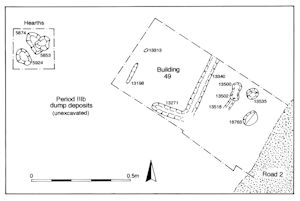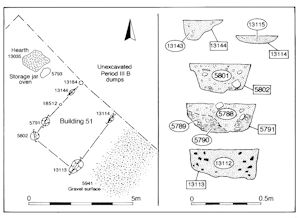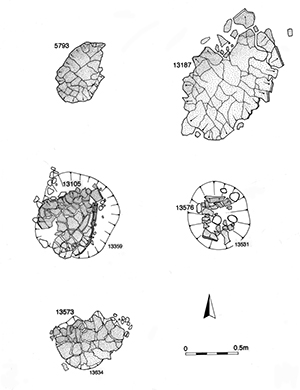
Following the concerted episode of dumping that marks the end of Period 3A and beginning of 3B activity in Open Area A18, this enclosure is reoccupied. However, the nature of its use is now markedly different from that of the Period 2B/3A roundhouses. The imposition of a major fenceline seemingly bisects OA18 into two sub-plots during Period 3B (Figure 83). These are referred to as the eastern sub-plot, OA18(e), and western sub-plot, OA18(w) henceforth.
S36 denotes the position of a substantial wooden fence bisecting OA18, representing the subdivision of the plot as part of its 2nd century reoccupation following the raising of its land surface. Its imposition possibly coincides with that of the fenceline (Structure 37) along part of the Road 1 and 2 frontage, as marked by a similar line of clay-packed oval post-holes mostly c. 0.7m wide and 0.3-0.4m deep. Two of its component post-holes, 13014, 13015 (Group 608), are apparently sealed by roadwash deposits (Group 609) which are in turn cut by further post-holes (5717, 5769, 13067, 13086, 13088, 13111, 13131, 13133, 13535, 18763, 21056, 21058, 13403 Group 610). All but southernmost post-holes 13014, 13015 (Group 608), 13535 and 18763 (Group 610) are packed with clean orange clay and contain clear, vertical, post-pipes that show the posts themselves to be 0.15m-0.20m diameter. Group 608 may represent an earlier phase of this structure (though 13014 may simply be the base of a Group 610 posthole).
Two further clay-packed post-holes 13465 and 18719, located toward the centre of OA18(e), may represent another, eastward, subdivision of the overall OA18 plot, though admittedly very little of this line is traced. The lack of investigation in this part of the enclosure allows little validation of this supposition, with only a single Period 3B feature recorded to the north of its presumed line.
Essentially, midden- or dump-type deposits continue to accumulate within Open Area 18 during this phase of reoccupation following the major dumping episode).
Further midden-type deposits comprising dark brown silts containing pottery spreads and charcoal lenses (5936, 5951, 13451, 13514, 13596, 13597, 18356, 18359, 18362, 18363, 18364, 18365, 18366, 18367 Group 606), which seal the Group 605 surfaces associated with hearths and also overlie some storage jar ovens such as Group 604, pre-date most of the Period 3B activity in this eastern part of OA18. The extent to which these layers relate to rubbish-rich midden dump 5494 (Group 631) that marks the (at least partial) demise of Structure 37 is unclear.

Building 49 (Group 618) is principally represented by substantial right-angled slot 13271/13249 (Figure 84). Three metres to its west, smaller slot 13198 and post-hole 13313 form a parallel alignment; perhaps denoting an internal subdivision rather than constituting the back wall of this building. Traces of carbonised wood in the fill of slot 13271 may suggest destruction by fire. Building 49 is located on the frontage to Road 2, set back some 3.5m from its edge.

A conspicuous, isolated cluster of post-holes 5791, 5802, 13113, and 13114 (Group 628) may constitute a rectilinear structure (Building 51) with hearths 5793 and 13035 (Group 629) just to the north-west (Figure 85). It is noted that outlying post-holes 13144 (Group 596) and 13130 (Group 597) were originally considered to be part of Building 51. However, both are apparently sealed by the midden deposits of Group 600 (though could equally have been obscured within them and could still have been part of Building 51).

As in the western sub-plot of OA18, the eastern sub-plot features a number of hearths and storage jar ovens (examples of type in Figure 115), generally sitting on or into the surface of the dump deposits. Some ovens, such as 5946 and 5948 (Group 604) are disturbed by later activity and truncated by machining. Some, therefore, amount to little more than concentrations of broken storage jar (e.g. 5665 Group 632) that may perhaps be regarded as dubious as ovens.
Fewer are evident on the surface of the dumped silts on this side of the enclosure. However, where they occur, hearths and ovens again both co-exist and display inter-cutting and replacement as is the case in OA18(w).
Some hearths are simply concentrations of scorched stones, such as 5853 (Group 760). Shallow depression 5924 (Group 624) contains a layer of scorched pebbles overlain by a deposit of burnt clay. The inter-cut sequence of these hearths shows that there are at least three phases of hearth use (e.g. 5924, 5882 and 5874 (Groups 991 and 760, again demonstrating their short life and continued use as a place of food preparation.
Further, less certain, ovens, hearths and/or fire pits are present elsewhere in OA18(e) (i.e. 5692, 5882, 5904, 5921 Group 991).
Although excavation is of limited extent within OA18(e), the paucity of early Roman pits cutting the dump deposits is perhaps conspicuous. The sole example is isolated pit 13469 (Group 611), located to the north of Building 49. This shallow 1.6m diameter cut contains a complete ceramic bowl placed at its bottom. Its silt fills include fragments of building stone.
Internet Archaeology is an open access journal based in the Department of Archaeology, University of York. Except where otherwise noted, content from this work may be used under the terms of the Creative Commons Attribution 3.0 (CC BY) Unported licence, which permits unrestricted use, distribution, and reproduction in any medium, provided that attribution to the author(s), the title of the work, the Internet Archaeology journal and the relevant URL/DOI are given.
Terms and Conditions | Legal Statements | Privacy Policy | Cookies Policy | Citing Internet Archaeology
Internet Archaeology content is preserved for the long term with the Archaeology Data Service. Help sustain and support open access publication by donating to our Open Access Archaeology Fund.